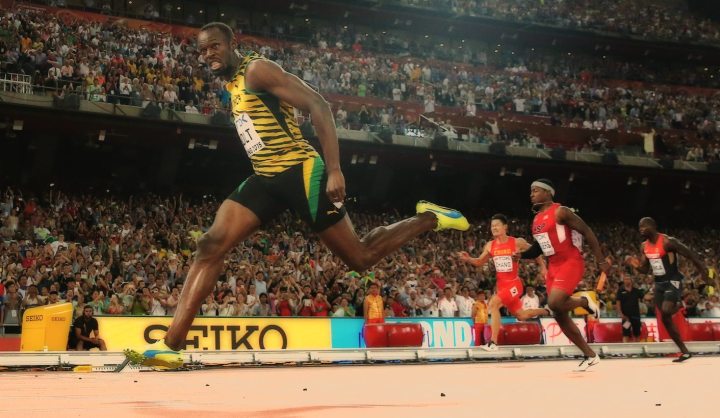Sport
How fast can you go? Exploring the limits of kinetic potential

Every day, elite athletes and coaches earn a living by pushing the boundaries of human potential. The dividing line between what was once considered impossible and what is now a prerequisite for success is constantly shifting. Michael Johnson, one of the best athletes that has ever lived, has created a high performance centre that is the world’s leading speed factory. It is here that athletes from all over the world improve their speed and where the limitations of athletic capabilities are being explored. By DANIEL GALLAN for CONQA SPORT.
This article first appeared on Conqa Sport and has been republished with permission.
Before Roger Bannister ran a mile in under four minutes in 1954, the feat was deemed physically impossible. In the nearly 100 years of athletes running recorded miles, from Charles Westhall’s 4:28 in 1855 to Arne Andersson’s 4:01 in 1945, the barrier appeared insurmountable.
Andersson’s record stood for 10 years before Bannister went where no human had gone before. Since then, the record has been lowered 17 times with Morocco’s Hicham El Guerrouj holding it at 3:43. Today the four-minute barrier is the standard that all elite male middle distance runners are measured against.
Overcoming what was once considered impossible is now something that elite athletes seek to do every day. Before 1968, no man had ever run the 100m dash in less than 10 seconds. Since Jim Hines did so at the Mexico City Olympic Games, 107 men have stepped over a threshold now considered a prerequisite to be taken seriously in the sport.
Athletically, we haven’t just gone to the moon, we’ve built colonies on its pock-marked surface and are now looking to do so elsewhere in the infinite cosmos of athletic potential.
Conventional wisdom dictates that we will reach a ceiling at some point, and perhaps we already have, yet all historical evidence indicates that we are constantly on an upward trajectory. It is hard to fathom that one day a human being will beat Usain Bolt’s record of 9.58s over 100m, but then again, if you were to go back to 1968, the same would have been said of the 10s barrier. What lies ahead is simultaneously enthralling and frightening and if you feel a mix of the two, you find yourself in esteemed company.
Lance Walker is the Global Director of Performance at the Michael Johnson Performance (MJP) centre in McKinney, Texas and freely admits that he is afraid of what is beyond the horizon in terms of human capability.
He says, “Every day I see limitations get knocked down and the boundaries redrawn. We’re constantly reimagining the possibilities and finding out that what we thought was hypothetical is actually just a matter of time. It really is scary to think about where we’re going.”
Scary as it may be, Walker is driven by the understanding that the dividing line between what is attainable and what is impossible is constantly moving. After all, if that line were ever considered definitive, his organisation would have to close its doors.
MJP is a stateof-the-art factory that focuses on producing one product: a faster athlete. It’s a 24/7 bespoke production line that puts athletes from any sport, at any level, at any age group on one end, and finds a way to improve their speed once they reach the other side.
No stone is left unturned; stride length, co-ordination, reactive ground forces, weight training, the kinematics of arm action, sleep patterns, nutrition, flexibility, equipment, even neurocranial stimulation; the pursuit of speed is a multifactorial journey that seeks to eke out the smallest margins of improvement. Athletes spend months, even years, searching for 0.01 of a second as the margins between cementing a place in history and languishing in obscurity are getting smaller every race.
“There are very few times that an athlete reaches their 100 perent potential,” Walker says. “There is always a fraction of a second lying around on the training floor somewhere and we go and look for everything we possibly can. We know that small improvements are everywhere and we always go and get them.”
Driven by one of the greatest athletes ever to have lived, MJP focuses on professionalising speed training. Michael Johnson has not only stamped his name above the doors of this speed factory, he has also embedded the same philosophy and attention to detail that made him so successful.
Still the holder of the 400m record (43.18s set in Seville in 1999), Johnson is the owner of four Olympic and eight World Championship gold medals. According to Walker, and assuring us that the man in question would agree, Johnson would not have achieved all he had were it not for the realisation that extra fractions of a second can be found all over the place if you know where to look.
“He hated lifting weights,” Walker says. “He didn’t think it was worth a darn or that it would help him.” He didn’t, at least until he started seeing these important regimes as a business transaction; time and energy spent for a return on speed.
That is the same approach to training that MJP has adopted. They see themselves as providing a service that athletes and organisations spend a lot of time and money on and expect to see a tangible return. Like most bespoke businesses, MJP are in the fortunate position of not having to concern themselves with any other variable found in their field.
Variables such as pre-match planning, tactical plays, recruiting or scouting are not scrutinised at MJP. This allows them to be agnostic to sport which brings a multitude of disciplines and codes through their doors. Walker describes the organisation as a “global clearing house for best practices in speed development” and they have become inundated with athletes searching for that extra step.
It’s not just sprinters; all athletes come in search of extra speed. It’s not even just athletes that are involved in sports where straight line speed is a competitive advantage (football, rugby, basketball); athletes who compete in nonlinear speed sports also benefit from the series provided by MJP.
Athletes whose job it is to throw a baseball, lift heavy weights or launch a javelin improve their performances by incorporating speed training in their regimes. Improving neuromuscular speed has shown to transfer to other variables of performance as speed is fundamental to athleticism.
“It’s a high output thing,” Walker says. “We’re tapping into the subcomponent of speed” and that has the potential to improve output where it matters. Besides, if all things are equal, wouldn’t your rather have a faster athlete no matter the code?
It’s important to note, though, that MJP does not promise to turn any athlete into the next Usain Bolt or Shelly-Ann Fraser-Pryce. When Justin Durandt, a leading sports scientist at the Sport Institute of South Africa, told David Epstein in The Sports Gene (2013), that he’d “never seen a slow kid become fast”, he didn’t quite paint the whole picture.
While his sentiments ring true, they do not apply to the objectives at MJP. Athletes are not expected to become fast, but faster, and every athlete who embarks on a highly individualised programme achieves this goal.
As Epstein’s book shows, we are limited in some ways by our genetic predisposition but speed can always be improved. Walker and his colleagues at MJP see to that on a week-to-week basis.
Speed can even improve on the day, just before competition. Simple adjustments such as clearing one’s own body out of the start blocks have immediate effect on the athlete’s straight line speed and this can take a matter of hours. Muscles can be potentiated by using heavy weights in small doses before an event or simply getting a good night’s sleep can have an immediate effect.
In the same way that Michelangelo said that every block of stone has a sculpture hidden inside it, and that you just have to remove what is not necessary, so too does every athlete have hidden speed locked away. All the coaches at MJP are doing is exposing the potential that was always there.
The time it takes to unlock that potential often comes down to the natural athletic ability of the athlete. Not necessarily in terms of physiological capabilities, but in how quickly the athlete can cognitively cotton on to new techniques and training methods. The better the athlete, the quicker he or she is able to improve their speed through these adjustments. As Walker says, “There is an underpinning to speed that centres on the more robust concept of athleticism.”
This helps explain why Usain Bolt is so successful. Sure, he has those long levers that most sprinters don’t possess, but he has honed a technique whereby the ground forces and angles that he throws down propel him to speeds that other tall athletes can’t reach.
Apart from having the right body for speed and the right technique to complement it, Walker maintains that the most important component to speed is the mental state of the athlete. “Psychology will beat physiology every single day,” Walker says. “If you don’t have that psychology right, even when it comes to running fast, you’re going to be pushing a rock up a hill.”
Look at Bolt just before he starts a race. He exudes confidence. You can see it in his eyes, in the ease with which he moves, in the way he stands tall like there is no one else that matters. He’s not racing against seven other men; no one can possibly race against him. Like all champion athletes, his confidence lies not only in his ability, but in his preparation and understanding that he has done all he can before the race.
Confidence can propel an athlete to speeds he or she never achieved in training but a lack of it can have the reverse effect. Abstract concepts manifest themselves in overt fluctuations in performance.
The NFL Scouting Combine is an annual week-long event where college football players perform physical and mental tests in front of NFL coaches, scouts and GMs. These young men are stripped down to nothing more than tight-fitting clothes and have to perform like they’ve never performed before. Many of them consult MJP coaches beforehand in an attempt to up their athletic capabilities with an emphasis on speed.
This is an environment without cheerleaders or crowds; the players have no pads and are asked to perform many tasks without a ball in play. They are completely out of their comfort zone with so much riding on their performance. This can be too much for some athletes.
“There are athletes that we’ll look at and we know they should be running their 40-yard dash in 4.3 seconds, but they only manage a 4.5 or 4.6,” Walker says, citing nerves as a result of pressure as the cause.
Pressure seeps into an athlete’s subconscious and impacts on performance. This is easier to understand in skill-based sports such as cricket or golf, but one has to be mindful that even in a purely physiological activity, like running in a straight line as fast as you can, pressure can easily lead to subpar results.
The aim is to get an athlete to perform in a subcerebral state. His or her actions must be subcortical; they need to happen without overthinking. At the 2008 Combine, Darren McFadden, now with the Dallas Cowboys, ran the 40-yard dash in just 4.27s. He phoned Walker immediately afterwards, elated, but confessed that he had no recollection of actually running. He said it felt as though he had jumped out of the blocks and it was over immediately.
His next 40-yard dash was completed in 4.5 seconds. He was now thinking about it. There could have been any number of reasons why McFadden’s second attempt was much slower but Walker is adamant that his consciousness got in the way.
That is why Walker is scared to think about the limits of human potential. If conscious thought can limit the body’s physical performance, what could potentially be unlocked if the brain didn’t get in the way?
MJP has partnered with Halo Neuroscience, a company that seeks to unlock the body’s full potential using neuropriming – “pulses of energy that increases excitability of moto neurons” – which accelerate strength and skills acquisition in athletes. The results have been incredible and Walker says, “It’s going to rewrite how we think about training.”
The brain’s potential to unlock performance is the new frontier in athletic training. If Walker is right, athletic ability is on the verge of a new dawn. What was considered ludicrous will soon become the norm.
This development will not be happening in isolation either. Training methods, nutrition programmes, strategies and equipment will constantly improve. Not only that, the 0.01 percent of the human population that constitute the best athletes on the planet will steadily increase in terms of athletic output simply through natural selection.
With athletic capabilities starting to enter the realm of science-fiction, there really is no telling how far we can go. What is certain is that if anyone is going to figure it out, the odds are that it is going to be someone working in the Michael Johnson Performance centre. DM
Photo: Jamaica’s Usain Bolt brings home gold in the 4x100m men relay during the Beijing 2015 IAAF World Championships at the National Stadium, also known as Bird’s Nest, in Beijing, China, 29 August 2015. EPA/DIEGO AZUBEL



















 Become an Insider
Become an Insider